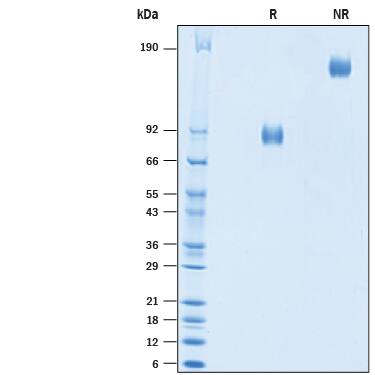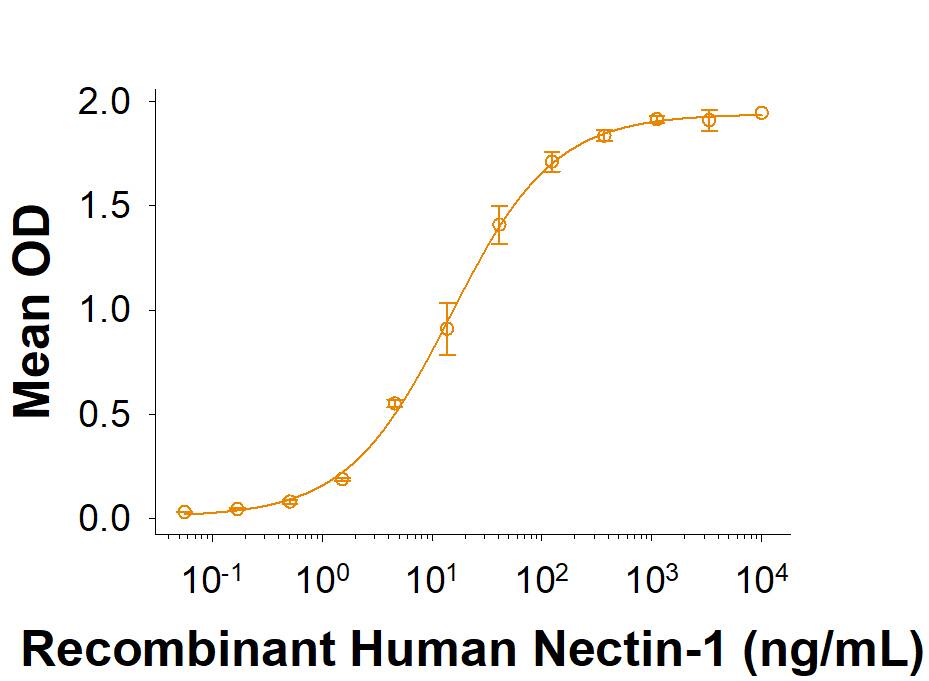Recombinant Human Nectin-1 Fc Chimera Protein, CF
R&D Systems, part of Bio-Techne | Catalog # 10697-N1

Key Product Details
Source
HEK293
Accession #
Structure / Form
Disulfide-linked homodimer
Conjugate
Unconjugated
Applications
Bioactivity
Product Specifications
Source
Human embryonic kidney cell, HEK293-derived human Nectin-1 protein
| Human Nectin-1 (Gln31-Gly346) Accession # Q15223.3 |
IEGRMD | Human IgG1 (Pro100-Lys330) |
| N-terminus | C-terminus |
Purity
>95%, by SDS-PAGE visualized with Silver Staining and quantitative densitometry by Coomassie® Blue Staining.
Endotoxin Level
<0.10 EU per 1 μg of the protein by the LAL method.
N-terminal Sequence Analysis
Gln31, inferred from enzymatic deblocking revealing Val32
Predicted Molecular Mass
83 kDa
SDS-PAGE
78-88 kDa, under reducing conditions
Activity
Measured by its binding ability in a functional ELISA.
When Recombinant Human Nectin-3 (Catalog # 3064-N3) is immobilized at 1 µg/mL (100 µL/well), Recombinant Human Nectin-1 Fc Chimera (Catalog # 10697-N1) binds with an ED50 of 2.5-20 ng/mL.
Scientific Data Images for Recombinant Human Nectin-1 Fc Chimera Protein, CF
Recombinant Human Nectin-1 Fc Chimera Protein Binding Activity.
When Recombinant Human Nectin-3 (3064-N3) is immobilized at 1 μg/mL (100 μL/well), Recombinant Human Nectin-1 Fc Chimera (Catalog # 10697-N1) binds with an ED50 of 2.5-20 ng/mL.Recombinant Human Nectin-1 Fc Chimera Protein SDS PAGE.
2 μg/lane of Recombinant Human Nectin-1 Fc Chimera Protein (Catalog # 10697-N1) was resolved with SDS-PAGE under reducing (R) and non-reducing (NR) conditions and visualized by Coomassie® Blue staining, showing bands at 78-88 kDa and 156-176 kDa, respectively.Formulation, Preparation and Storage
10697-N1
| Formulation | Lyophilized from a 0.2 μm filtered solution in PBS. |
| Reconstitution | Reconstitute at 500 μg/mL in PBS. |
| Shipping | The product is shipped at ambient temperature. Upon receipt, store it immediately at the temperature recommended below. |
| Stability & Storage | Use a manual defrost freezer and avoid repeated freeze-thaw cycles.
|
Background: Nectin-1
References
- Lopez, M. et al. (1995) Gene 155:261.
- Takai, Y. et al. (2008) Nat. Rev. Mol. Cell Biol. 9:603.
- Fabre, S. et al. (2002) J. Biol. Chem. 277:27006.
- Lopez, M. et al. (2001) J. Virol. 75:5684.
- Cocchi, F. et al. (1998) Proc. Natl. Acad. Sci. USA 95:15700.
- Linehan, M. M. et al. (2004) J. Virol. 78:2530.
- Simpson, S. A. et al. (2005) J. Neurovirol. 11:208.
- Mizoguchi, A. et al. (2002) J. Cell Biol. 156:555.
- Togashi, H. et al. (2006) J. Cell Biol. 174:141.
- Tachibana, K. et al. (2000) J. Cell Biol. 150:1161.
- Takai, Y. and H. Nakanishi (2003) J. Cell Science 116:17.
- Seth, S. et al. (2007) Biochem. Biophys. Res. Commun. 364:959.
- Suzuki, K. et al. (2000) Nat. Genet. 25:427.
- Tanaka, Y. et al. (2002) Biochem. Biophys. Res. Commun. 299:472.
- Tampakis, A. et al. (2019) Oncology. 96:318.
Long Name
Poliovirus Receptor Related 1
Alternate Names
CD111, HVEC, Nectin1, PRR1, PVRL1, PVRR1
Gene Symbol
NECTIN1
UniProt
Additional Nectin-1 Products
Product Documents for Recombinant Human Nectin-1 Fc Chimera Protein, CF
Product Specific Notices for Recombinant Human Nectin-1 Fc Chimera Protein, CF
For research use only
